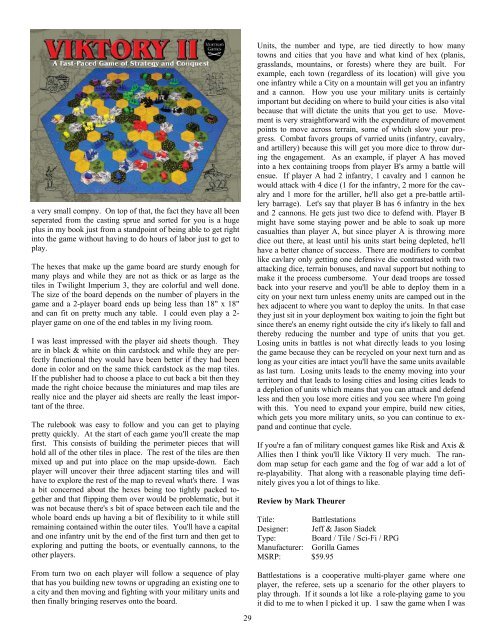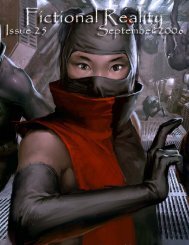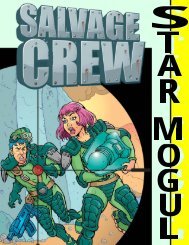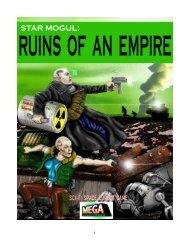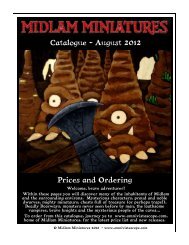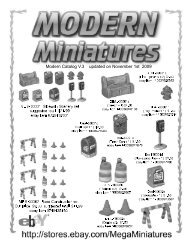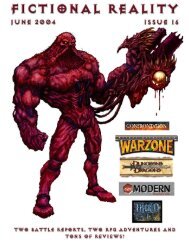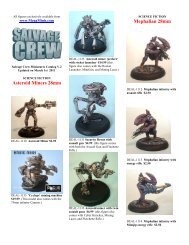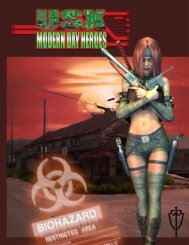Download - Mega Miniatures
Download - Mega Miniatures
Download - Mega Miniatures
Create successful ePaper yourself
Turn your PDF publications into a flip-book with our unique Google optimized e-Paper software.
a very small compny. On top of that, the fact they have all been<br />
seperated from the casting sprue and sorted for you is a huge<br />
plus in my book just from a standpoint of being able to get right<br />
into the game without having to do hours of labor just to get to<br />
play.<br />
The hexes that make up the game board are sturdy enough for<br />
many plays and while they are not as thick or as large as the<br />
tiles in Twilight Imperium 3, they are colorful and well done.<br />
The size of the board depends on the number of players in the<br />
game and a 2-player board ends up being less than 18" x 18"<br />
and can fit on pretty much any table. I could even play a 2-<br />
player game on one of the end tables in my living room.<br />
I was least impressed with the player aid sheets though. They<br />
are in black & white on thin cardstock and while they are perfectly<br />
functional they would have been better if they had been<br />
done in color and on the same thick cardstock as the map tiles.<br />
If the publisher had to choose a place to cut back a bit then they<br />
made the right choice because the miniatures and map tiles are<br />
really nice and the player aid sheets are really the least important<br />
of the three.<br />
The rulebook was easy to follow and you can get to playing<br />
pretty quickly. At the start of each game you'll create the map<br />
first. This consists of building the perimeter pieces that will<br />
hold all of the other tiles in place. The rest of the tiles are then<br />
mixed up and put into place on the map upside-down. Each<br />
player will uncover their three adjacent starting tiles and will<br />
have to explore the rest of the map to reveal what's there. I was<br />
a bit concerned about the hexes being too tightly packed together<br />
and that flipping them over would be problematic, but it<br />
was not because there's s bit of space between each tile and the<br />
whole board ends up having a bit of flexibility to it while still<br />
remaining contained within the outer tiles. You'll have a capital<br />
and one infantry unit by the end of the first turn and then get to<br />
exploring and putting the boots, or eventually cannons, to the<br />
other players.<br />
Units, the number and type, are tied directly to how many<br />
towns and cities that you have and what kind of hex (planis,<br />
grasslands, mountains, or forests) where they are built. For<br />
example, each town (regardless of its location) will give you<br />
one infantry while a City on a mountain will get you an infantry<br />
and a cannon. How you use your military units is certainly<br />
important but deciding on where to build your cities is also vital<br />
because that will dictate the units that you get to use. Movement<br />
is very straightforward with the expenditure of movement<br />
points to move across terrain, some of which slow your progress.<br />
Combat favors groups of varried units (infantry, cavalry,<br />
and artillery) because this will get you more dice to throw during<br />
the engagement. As an example, if player A has moved<br />
into a hex containing troops from player B's army a battle will<br />
ensue. If player A had 2 infantry, 1 cavalry and 1 cannon he<br />
would attack with 4 dice (1 for the infantry, 2 more for the cavalry<br />
and 1 more for the artiller, he'll also get a pre-battle artillery<br />
barrage). Let's say that player B has 6 infantry in the hex<br />
and 2 cannons. He gets just two dice to defend with. Player B<br />
might have some staying power and be able to soak up more<br />
casualties than player A, but since player A is throwing more<br />
dice out there, at least until his units start being depleted, he'll<br />
have a better chance of success. There are modifiers to combat<br />
like cavlary only getting one defensive die contrasted with two<br />
attacking dice, terrain bonuses, and naval support but nothing to<br />
make it the process cumbersome. Your dead troops are tossed<br />
back into your reserve and you'll be able to deploy them in a<br />
city on your next turn unless enemy units are camped out in the<br />
hex adjacent to where you want to deploy the units. In that case<br />
they just sit in your deployment box waiting to join the fight but<br />
since there's an enemy right outside the city it's likely to fall and<br />
thereby reducing the number and type of units that you get.<br />
Losing units in battles is not what directly leads to you losing<br />
the game because they can be recycled on your next turn and as<br />
long as your cities are intact you'll have the same units available<br />
as last turn. Losing units leads to the enemy moving into your<br />
territory and that leads to losing cities and losing cities leads to<br />
a depletion of units which means that you can attack and defend<br />
less and then you lose more cities and you see where I'm going<br />
with this. You need to expand your empire, build new cities,<br />
which gets you more military units, so you can continue to expand<br />
and continue that cycle.<br />
If you're a fan of military conquest games like Risk and Axis &<br />
Allies then I think you'll like Viktory II very much. The random<br />
map setup for each game and the fog of war add a lot of<br />
re-playability. That along with a reasonable playing time definitely<br />
gives you a lot of things to like.<br />
Review by Mark Theurer<br />
Title: Battlestations<br />
Designer: Jeff & Jason Siadek<br />
Type: Board / Tile / Sci-Fi / RPG<br />
Manufacturer: Gorilla Games<br />
MSRP: $59.95<br />
From turn two on each player will follow a sequence of play<br />
that has you building new towns or upgrading an existing one to<br />
a city and then moving and fighting with your military units and<br />
then finally bringing reserves onto the board.<br />
29<br />
Battlestations is a cooperative multi-player game where one<br />
player, the referee, sets up a scenario for the other players to<br />
play through. If it sounds a lot like a role-playing game to you<br />
it did to me to when I picked it up. I saw the game when I was


